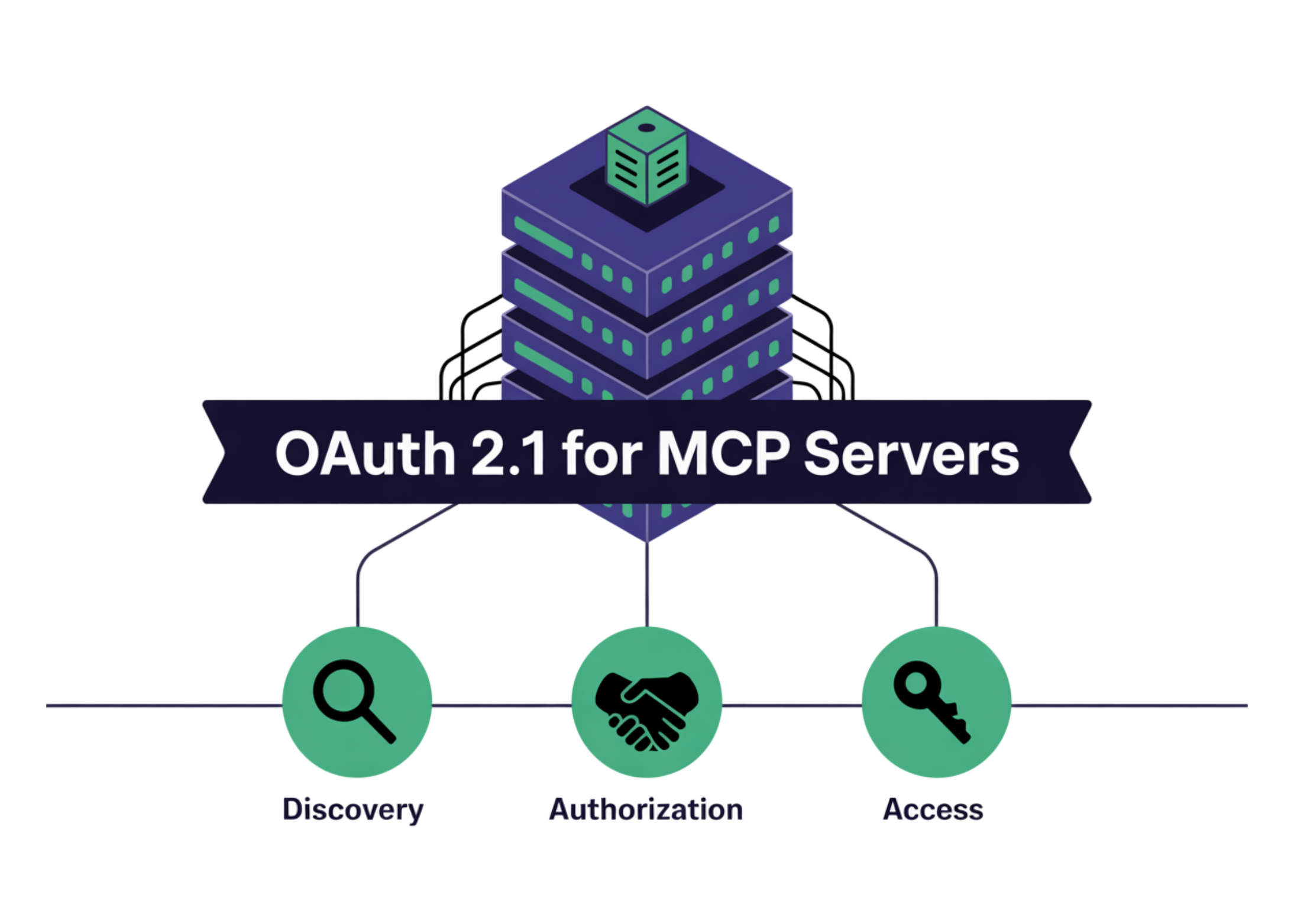Blog
Understanding OAuth 2.1 for MCP (Model Context Protocol) Servers: Discovery, Authorization, and Access Phases

Introduction to OAuth 2.1 and MCP Servers
In the digital landscape, security and functionality are paramount, especially in platforms that handle sensitive data. OAuth 2.1 emerges as a comprehensive solution for authorization, particularly when integrated with Model Context Protocol (MCP) servers. This article delves into the essentials of OAuth 2.1, its relationship with MCP servers, and the phases of discovery, authorization, and access.
What is OAuth 2.1?
OAuth 2.1 is a streamlined and more secure version of the OAuth 2.0 authorization framework. Designed to facilitate third-party applications’ access to user data without sharing passwords, OAuth 2.1 consolidates previous updates and clarifications from OAuth 2.0 and RFC 6749. By managing scopes and permissions, it significantly enhances data protection while simplifying the authentication process.
Key Features of OAuth 2.1
- Simplicity and Clarity: OAuth 2.1 integrates the best practices and recommendations from OAuth 2.0 into a single document, making it easier for developers and organizations to implement.
- Improved Security: It mandates the use of Proof Key for Code Exchange (PKCE) for all public clients, helping to mitigate authorization code interception attacks.
- Streamlined Endpoint Discovery: OAuth 2.1 introduces mechanisms for automatic discovery of authorization servers to reduce configuration complexity.
The Role of MCP Servers
Model Context Protocol (MCP) servers play a critical role in modern application ecosystems. MCP facilitates the exchange of contextual data about users, devices, and environments, allowing applications to deliver more personalized and relevant experiences. Integrating OAuth 2.1 with MCP servers enhances security when handling sensitive contextual information.
Phases of OAuth 2.1: Discovery, Authorization, and Access
Discovery Phase
The discovery phase is essential for establishing secure connections between clients and authorization servers. This phase involves locating and retrieving metadata about the available authorization endpoints and supported features.
Steps in the Discovery Phase
- Endpoint Retrieval: Clients initiate the discovery process by querying a well-known configuration URL defined in the OpenID Connect or OAuth 2.1 specifications.
- Metadata Extraction: Upon receiving the configuration, clients obtain crucial metadata, including authorization endpoint URLs, supported response types, and available scopes.
- Validation: Clients validate the received metadata to ensure integrity and correctness, reducing the risk of misconfigurations.
Benefits of a Proper Discovery Phase
A smooth discovery phase minimizes errors during authentication, leading to a streamlined user experience. By automating endpoint discovery, developers can focus on application functionality, knowing that the essential configurations are reliable and up-to-date.
Authorization Phase
Once discovery is complete, the next step is the authorization phase. This phase involves obtaining user consent and generating tokens that grant access to protected resources.
Steps in the Authorization Phase
- Authorization Request: The client redirects the user to the authorization server with a request containing parameters such as client ID, requested scopes, and redirect URI.
- User Consent: The authorization server authenticates the user and prompts them to grant or deny access. This step is critical, as it ensures that users have control over their data.
- Authorization Response: If granted, the server issues an authorization code that the client can exchange for an access token.
Importance of User Consent
User consent is at the heart of OAuth 2.1, aligning with data protection regulations like GDPR. By clearly outlining what data will be accessed and how it will be used, developers foster trust and transparency with users.
Access Phase
The access phase concludes the authorization flow, allowing clients to retrieve protected resources using the access tokens obtained in the previous phase.
Steps in the Access Phase
- Token Exchange: The client requests an access token from the authorization server by exchanging the received authorization code. This token is uniquely associated with the user and the requested scopes.
- Resource Access: With the access token in hand, the client can now request access to protected resources from the resource server, such as user profiles or specific datasets.
- Token Renewal: Tokens typically have a limited lifespan. Clients must handle token expiration by implementing refresh tokens, allowing for seamless access without needing reauthorization from users.
The Significance of Secure Resource Access
Securing access to resources is vital for any modern application. By using access tokens, OAuth 2.1 ensures that only authorized clients can interact with sensitive data, protecting it from unauthorized access.
Challenges and Best Practices
While implementing OAuth 2.1 with MCP servers brings numerous advantages, developers may face challenges. These include ensuring compatibility with existing systems, managing token lifecycles, and maintaining user trust.
Key Challenges
- Legacy System Integration: Adapting older applications to support OAuth 2.1 can be complex, requiring substantial modifications.
- Token Management: Implementing robust strategies for token storage, renewal, and revocation is crucial for maintaining security.
- Monitoring and Logging: Establishing logging and monitoring for authorized access can help detect anomalies and enhance security.
Best Practices for Implementation
- Follow Specifications: Adhere closely to the OAuth 2.1 specifications to avoid common pitfalls and ensure best security practices.
- Utilize PKCE: Always implement Proof Key for Code Exchange to protect against code interception attacks, especially in public clients.
- Educate Users: Provide clear information about data usage and privacy to foster user trust and understanding.
Conclusion
Understanding OAuth 2.1 in the context of MCP servers is crucial for building secure and user-friendly applications. By breaking down the discovery, authorization, and access phases, developers can create a robust authentication framework that prioritizes user consent and data protection. Embracing best practices in implementation will further enhance security, paving the way for a modern, secure digital experience. As technology continues to evolve, staying abreast of advancements in authorization protocols will remain vital in fostering trust and maintaining data integrity.

